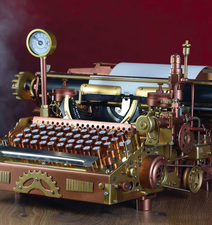Reinventing the keyboard
Open Hardware – Keyboardio

© Lead Image © 3355m, 123RF.com
The Keyboardio Model 01 is a highly-customizable open hardware keyboard.
For a while, the Keyboardio [1] Model 01 seemed destined to never ship. Although its 2015 crowdfunding campaign raised over five times its goal of $120,000, production was repeatedly thwarted by problems with manufacturers and quality control – all of which is recorded in painstaking detail on the company blog [2], and which should become required reading for any would-be hardware vendor. Yet despite everything, in November 2017, the Model 01 keyboard finally began shipping. Although shipping is still seriously backlogged, the Model 01 (Figure 1) turns out to be worth waiting for, both as a high-end ergonomic keyboard and as one of the most customizable pieces of open hardware ever produced.
The Model 01 is a mechanical keyboard built with Matias keyswitches [3] that are not only longer-lasting and easier to repair than the usual cheap membrane keyboards, but require less pressure to activate than standard keyswitches. The minimalist keyboard of 64 keys ships with three layers – that is, key bindings that can be activated while pressing a command key, just as the default lowercase keys produce uppercase letters when the Shift key is pressed. With the Model 01, pressing the Num key activates the number pad and arrow keys, while pressing the Fn key activates the 12 function keys, Delete, and square and curly brackets. The default layers are illustrated on a laminated sheet that ships with the Model 01.
[...]
Buy this article as PDF
(incl. VAT)
Buy Linux Magazine
Subscribe to our Linux Newsletters
Find Linux and Open Source Jobs
Subscribe to our ADMIN Newsletters
Support Our Work
Linux Magazine content is made possible with support from readers like you. Please consider contributing when you’ve found an article to be beneficial.

News
-
Linux Mint 22.3 Now Available with New Tools
Linux Mint 22.3 has been released with a pair of new tools for system admins and some pretty cool new features.
-
New Linux Malware Targets Cloud-Based Linux Installations
VoidLink, a new Linux malware, should be of real concern because of its stealth and customization.
-
Say Goodbye to Middle-Mouse Paste
Both Gnome and Firefox have proposed getting rid of a long-time favorite Linux feature.
-
Manjaro 26.0 Primary Desktop Environments Default to Wayland
If you want to stick with X.Org, you'll be limited to the desktop environments you can choose.
-
Mozilla Plans to AI-ify Firefox
With a new CEO in control, Mozilla is doubling down on a strategy of trust, all the while leaning into AI.
-
Gnome Says No to AI-Generated Extensions
If you're a developer wanting to create a new Gnome extension, you'd best set aside that AI code generator, because the extension team will have none of that.
-
Parrot OS Switches to KDE Plasma Desktop
Yet another distro is making the move to the KDE Plasma desktop.
-
TUXEDO Announces Gemini 17
TUXEDO Computers has released the fourth generation of its Gemini laptop with plenty of updates.
-
Two New Distros Adopt Enlightenment
MX Moksha and AV Linux 25 join ranks with Bodhi Linux and embrace the Enlightenment desktop.
-
Solus Linux 4.8 Removes Python 2
Solus Linux 4.8 has been released with the latest Linux kernel, updated desktops, and a key removal.


